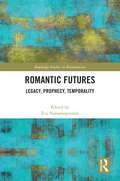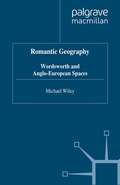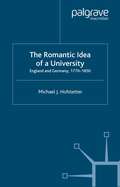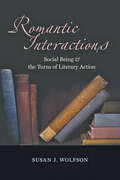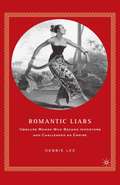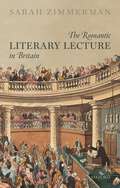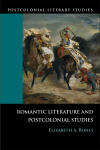- Table View
- List View
Romantic Friendship in Victorian Literature
by Carolyn W. OultonCarolyn Oulton recovers the strategies nineteenth-century authors used to justify the ideal of same-sex romantic friendship and the anxieties these strategies reveal. Informed by recent insights into the erotic potential of such relationships, but focused on romantic friendship as an independent and fully formulated ideal, Oulton departs from other critics who view romantic friendship as either nebulous and culturally naive or an invocation of homoerotic responsiveness. By considering both male and female friendships, Oulton uncovers surprising parallels between them in novels and poetry by authors such as Dickens, Tennyson, Disraeli, Charlotte Brontë, and Braddon. Oulton also examines conduct manuals, periodicals, and religious treatises, tracing developments from mid-century to the fin de siècle, when romantic friendship first came under serious attack. Her book is a persuasive challenge to those who view mid-Victorian England, existing in a state of blissful pre-Freudian innocence, as unproblematically accommodating of passionate same-sex relationships.
Romantic Futures: Legacy, Prophecy, Temporality (Routledge Studies in Romanticism)
by Evy VarsamopoulouRomantic Futures is a collection which explores the significance of futurity in British Romanticism from a comparative perspective in three defining manifestations: the future as conscious legacy, by which is meant both influences or continuities and the (anticipations of) impact on the future; the future as revealed by prophecy, whether via religious figures or superstitions; and, a meditation on the temporality of the future, or the future as a concept. The book brings together a wide range of theoretical and disciplinary perspectives: from utopian studies, history, religion and cultural theory to future studies, neuroscience, video games and art history. Aiming to increase and diversify current critical engagement and highlight the contemporary relevance of the Romantics’ multivalent preoccupation with the future, this collection renews the dialogue between Romanticism and our critical relation to its contemporaneity, especially as it speaks to current understandings of the future in the sciences, arts and humanities.
Romantic Futures: Legacy, Prophecy, Temporality (Routledge Studies in Romanticism)
Romantic Futures is a collection which explores the significance of futurity in British Romanticism from a comparative perspective in three defining manifestations: the future as conscious legacy, by which is meant both influences or continuities and the (anticipations of) impact on the future; the future as revealed by prophecy, whether via religious figures or superstitions; and, a meditation on the temporality of the future, or the future as a concept. The book brings together a wide range of theoretical and disciplinary perspectives: from utopian studies, history, religion and cultural theory to future studies, neuroscience, video games and art history. Aiming to increase and diversify current critical engagement and highlight the contemporary relevance of the Romantics’ multivalent preoccupation with the future, this collection renews the dialogue between Romanticism and our critical relation to its contemporaneity, especially as it speaks to current understandings of the future in the sciences, arts and humanities.
Romantic Geography: Wordsworth and Anglo-European Spaces (Romanticism in Perspective:Texts, Cultures, Histories)
by M. WileyGrounded in historical sources and informed by recent work in cultural, sociological, geographical and spatial studies, Romantic Geography illuminates the nexus between imaginative literature and geography in William Wordsworth's poetry and prose. It shows that eighteenth-century social and political interest groups contested spaces through maps, geographical commentaries and travel literature; and that by configuring 'utopian' landscapes Wordsworth himself participated in major social and political controversies in post-French Revolutionary England.
Romantic Hellenism and Women Writers (Palgrave Studies in the Enlightenment, Romanticism and Cultures of Print)
by N. CometExamining popular contexts of Greek revivalism associated with women, Comet challenges the masculine narrative of English Classicism by demonstrating that it thrived in non-male spaces, as an ephemeral ideal that betrayed a distrust of democratic rhetoric that ignored the social inequities of the classical world.
The Romantic Historicism to Come
by Jonathan CrimminsVacillating between the longue durée and microhistory, between ideological critique and historical sympathy, between the contrary formalisms of close and distant reading, literary historians operate with such disparate senses of what the term "history†? means that the field risks compartmentalization and estrangement. The Romantic Historicism to Come engages this uncertainty in order to construct a more robust, more capacious idea of history.Focusing attention on Romantic conceptions of history's connection to the future, The Romantic Historicism to Come examines the complications of not only Romantic historicism, but also our own contemporary critical methods: what would it mean if the causal assumptions that underpin our historical judgments do not themselves develop in a stable, progressive manner? Articulating history's minimum conditions, Jonathan Crimmins develops a theoretical apparatus that accounts for the concurrent influence of the various sociohistorical forces that pressure each moment. He provides a conception of history as open to radical change without severing its connection to causality, better addressing the problem of the future at the heart of questions about the past.
The Romantic Historicism to Come
by Jonathan CrimminsVacillating between the longue durée and microhistory, between ideological critique and historical sympathy, between the contrary formalisms of close and distant reading, literary historians operate with such disparate senses of what the term “history” means that the field risks compartmentalization and estrangement. The Romantic Historicism to Come engages this uncertainty in order to construct a more robust, more capacious idea of history.Focusing attention on Romantic conceptions of history's connection to the future, The Romantic Historicism to Come examines the complications of not only Romantic historicism, but also our own contemporary critical methods: what would it mean if the causal assumptions that underpin our historical judgments do not themselves develop in a stable, progressive manner? Articulating history's minimum conditions, Jonathan Crimmins develops a theoretical apparatus that accounts for the concurrent influence of the various sociohistorical forces that pressure each moment. He provides a conception of history as open to radical change without severing its connection to causality, better addressing the problem of the future at the heart of questions about the past.
The Romantic Idea of a University: England and Germany, 1770-1850 (Romanticism in Perspective:Texts, Cultures, Histories)
by M. HofstetterBy the late eighteenth century, universities in England and Germany had lost their sense of purpose. The romantics then presented them with a new one, a new Idea of a university. In Germany, Johann Gottlieb Fichte and others stressed that universities must teach more effectively; in England, Coleridge and Wordsworth attached to the German Idea a desire to keep the universities part of England's national church.
Romantic Image (Routledge Classics)
by Frank KermodeFor the past four decades Frank Kermode, critic and writer, has steadily established himself as one of the most brilliant minds of his generation. Questioning the public's harsh perception of 'the artist', Kermode at the same time gently pokes fun at artists' own, often inflated, self-image. He identifies what has become one of the defining characteristics of the Romantic tradition - the artist in isolation and the emerging power of the imagination. Back in print after an absence of over a decade, The Romantic Image is quintessential Kermode. Enlightenment has seldom been so enjoyable!
Romantic Image (Routledge Classics)
by Frank KermodeFor the past four decades Frank Kermode, critic and writer, has steadily established himself as one of the most brilliant minds of his generation. Questioning the public's harsh perception of 'the artist', Kermode at the same time gently pokes fun at artists' own, often inflated, self-image. He identifies what has become one of the defining characteristics of the Romantic tradition - the artist in isolation and the emerging power of the imagination. Back in print after an absence of over a decade, The Romantic Image is quintessential Kermode. Enlightenment has seldom been so enjoyable!
The Romantic Imagination and Astronomy: On All Sides Infinity (Palgrave Studies in the Enlightenment, Romanticism and Cultures of Print)
by Dometa Wiegand BrothersIn the nineteenth century the beauty of the night sky is the source of both imaginative wonder in poetry and political and commercial power through navigation. The Romantic Imagination and Astronomy examines the impact of astronomical discovery and imperial exploration on poets including Barbauld, Coleridge, Keats, Shelley, and Rossetti.
Romantic Influences: Contemporary — Victorian — Modern
by J. Beer'... a significant, wide-ranging study ... Above all, the book restores a salutary sense of the value of, and the difficult poise involved in, creative acts.' - Michael O'Neill, Durham University Taken together, these interlinked studies on topics such as the literary influences at work in the 1790s, Newman's resistance to Romantic ideas, the exact nature of Virginia Woolf's debt to Walter Pater and the counter-Romanticism of Lawrence and Eliot constitute a large reading of Romanticism from 1789 to our own day. They also throw light on the complex workings of influence itself, not least by showing how writers used images of fluency to describe their own creative processes.
Romantic Interactions: Social Being and the Turns of Literary Action
by Susan J. WolfsonIn Romantic Interactions, Susan J. Wolfson examines how interaction with other authors—whether on the bookshelf, in the embodied company of someone else writing, or in relation to literary celebrity—shaped the work of some of the best-known (and less well-known) writers in the English language. Working across the arc of Long Romanticism, from the 1780s to the 1840s, this lively study involves writing by women and men, in poetry and prose. Combining careful readings with sophisticated literary, historical, and cultural criticism, Wolfson reveals how various writers came to define themselves as "author." The story unfolds not only in deft textual analyses but also by provocatively placing writers in dialogue with what they were reading, with one another, and with the community of readers (and writers) their writings helped bring into being: Mary Wollstonecraft and Charlotte Smith in the Revolution-roiled 1790s; William Wordsworth and Dorothy Wordsworth in the society of the Lake District; Lord Byron, a magnet for writers everywhere, inspired, troubled, but always arrested by what he (and his scandal-ridden celebrity) represented. This fresh, informative account of key writers, important texts, and complex cultural currents promises keen interest for students and scholars, literary critics, and cultural historians.
Romantic Intimacy
by Nancy YousefHow much can we know about what other people are feeling and how much can we sympathize or empathize with them? The term "intimacy" captures a tension between a confidence in the possibility of shared experience and a competing belief that thoughts and feelings are irreducibly private. This book is an interdisciplinary study of shared feeling as imagined in eighteenth-century ethics, romantic literature, and twentieth-century psychoanalysis. Original interpretations of Hume, Rousseau, Kant, Wordsworth, Coleridge, and Austen show how mutual recognition gives way to the appreciation of varied, nonreciprocal forms of intimacy. The book concludes with accounts of empathy and unconscious communication in the psychoanalytic setting, revealing the persistence of romantic preoccupations in modernity. Yousef offers a compelling account of how philosophical confidence in sympathy is transformed by literary attention to uneven forms of emotional response, including gratitude, disappointment, distraction, and absorption. In its wide-ranging and eclectic engagement with current debates on the relationship between ethics, affect, and aesthetics, the book will be crucial reading for students of eighteenth- and nineteenth-century culture, as well as for literary theorists.
Romantic Legacies: Transnational and Transdisciplinary Contexts (Routledge Studies in Comparative Literature)
by Shun-Liang Chao John Michael CorriganRomantic Legacies: Transnational and Transdisciplinary Contexts presents the most wide-ranging treatment of Romantic regenerations, covering the cross-pollination between the arts or between art and thought within or across the borders of Germany, Britain, France, the US, Russia, India, China, and Japan. Each chapter in the volume examines a legacy or afterlife in a comparative context to demonstrate ongoing Romantic legacies as fully as possible in their complexity and richness. The volume provides readers a lens through which to understand Romanticism not merely as an artistic heritage but as a dynamic site of intellectual engagement that crosses nations and time periods and entails no less than the shaping of our global cultural currents.
Romantic Legacies: Transnational and Transdisciplinary Contexts (Routledge Studies in Comparative Literature)
by Shun-Liang Chao John Michael Corrigan James EngellRomantic Legacies: Transnational and Transdisciplinary Contexts presents the most wide-ranging treatment of Romantic regenerations, covering the cross-pollination between the arts or between art and thought within or across the borders of Germany, Britain, France, the US, Russia, India, China, and Japan. Each chapter in the volume examines a legacy or afterlife in a comparative context to demonstrate ongoing Romantic legacies as fully as possible in their complexity and richness. The volume provides readers a lens through which to understand Romanticism not merely as an artistic heritage but as a dynamic site of intellectual engagement that crosses nations and time periods and entails no less than the shaping of our global cultural currents.
The Romantic Legacy of Charles Dickens
by Peter CookThis book explores the relationship between Dickens and canonical Romantic authors: Blake, Wordsworth, Coleridge, Byron, Percy and Mary Shelley, and Keats. Addressing a significant gap in Dickens studies, four topics are identified: Childhood, Time, Progress, and Outsiders, which together constitute the main aspects of Dickens’s debt to the Romantics. Through close readings of key Romantic texts, and eight of Dickens’s novels, Peter Cook investigates how Dickens utilizes Romantic tropes to express his responses to the exponential growth of post-revolutionary industrial, technological culture and its effects on personal life and relationships. In this close study of Dickensian Romanticism, Cook demonstrates the enduring relevance of Dickens and the Romantics to contemporary culture.
The Romantic Legacy of Charles Dickens
by Peter CookThis book explores the relationship between Dickens and canonical Romantic authors: Blake, Wordsworth, Coleridge, Byron, Percy and Mary Shelley, and Keats. Addressing a significant gap in Dickens studies, four topics are identified: Childhood, Time, Progress, and Outsiders, which together constitute the main aspects of Dickens’s debt to the Romantics. Through close readings of key Romantic texts, and eight of Dickens’s novels, Peter Cook investigates how Dickens utilizes Romantic tropes to express his responses to the exponential growth of post-revolutionary industrial, technological culture and its effects on personal life and relationships. In this close study of Dickensian Romanticism, Cook demonstrates the enduring relevance of Dickens and the Romantics to contemporary culture.
The Romantic Legacy of Paradise Lost: Reading against the Grain (The Nineteenth Century Series)
by Jonathon ShearsThe Romantic Legacy of Paradise Lost offers a new critical insight into the relationship between Milton and the Romantic poets. Beginning with a discussion of the role that seventeenth and eighteenth-century writers like Dryden, Johnson and Burke played in formulating the political and spiritual mythology that grew up around Milton, Shears devotes a chapter to each of the major Romantic poets, contextualizing their 'misreadings' of Milton within a range of historical, aesthetic, and theoretical contexts and discourses. By tackling the vexed issue of whether Paradise Lost by its nature makes available and encourages alternate readings or whether misreadings are imposed on the poem from without, Shears argues that the Romantic inclination towards fragmentation and a polysemous aesthetic leads to disrupted readings of Paradise Lost that obscure the theme, or warp the 'grain', of the poem. Shears concludes by examining the ways in which the legacy of Romantic misreading continues to shape critical responses to Milton's epic.
The Romantic Legacy of Paradise Lost: Reading against the Grain (The Nineteenth Century Series)
by Jonathon ShearsThe Romantic Legacy of Paradise Lost offers a new critical insight into the relationship between Milton and the Romantic poets. Beginning with a discussion of the role that seventeenth and eighteenth-century writers like Dryden, Johnson and Burke played in formulating the political and spiritual mythology that grew up around Milton, Shears devotes a chapter to each of the major Romantic poets, contextualizing their 'misreadings' of Milton within a range of historical, aesthetic, and theoretical contexts and discourses. By tackling the vexed issue of whether Paradise Lost by its nature makes available and encourages alternate readings or whether misreadings are imposed on the poem from without, Shears argues that the Romantic inclination towards fragmentation and a polysemous aesthetic leads to disrupted readings of Paradise Lost that obscure the theme, or warp the 'grain', of the poem. Shears concludes by examining the ways in which the legacy of Romantic misreading continues to shape critical responses to Milton's epic.
Romantic Liars: Obscure Women Who Became Impostors and Challenged an Empire
by D. LeeLee unfolds the stories of six women with a cast of supporting characters such as Samuel Taylor Coleridge, Benjamin Franklin, Stamford Raffles and Napoleon against the grand narrative of England's 18th century empire building. This book is a meticulously researched, spellbinding tale of tragedy, transformation and triumph in the age of reason.
Romantic Literary Families (Nineteenth-Century Major Lives and Letters)
by S. KrawczykThe late eighteenth century witnessed the emergence of the literary family: a collaborative kinship network of family and friends that, by the end of the century, displayed characteristics of a nascent corporation. This book examines different models of collaboration within English literary families during the period 1760-1820. Beginning with the sibling model of Anna Barbauld and John Aikin, and concluding with the intergenerational model presented by the Godwins and the Shelleys, this study traces the conflict and cooperation that developed within and among literary families as they sought to leave their legacies on the English world of letters.
The Romantic Literary Lecture in Britain
by Sarah ZimmermanAt the beginning of the nineteenth century, the literary lecture arrived on London's cultural scene as an influential critical medium and popular social event. It flourished for two decades in the hands of the period's most prominent lecturers: Samuel Taylor Coleridge, John Thelwall, Thomas Campbell, and William Hazlitt. Lecturers aimed to shape auditors' reading habits, burnish their own professional profiles, and establish a literary canon. Auditors wielded their own considerable influence, since their sustained approbation was necessary to a lecturer's success, and independent series could collapse midway if attendance waned. Two chapters are therefore devoted to the auditors, whose creative responses to what they heard often constituted cultural works in their own right. Auditors wrote poems and letters about lecture performances, acted as patrons to lecturers, and hosted dinners and conversation parties that followed these events. Prominent auditors included John Keats, Mary Russell Mitford, Henry Crabb Robinson, Catherine Maria Fanshawe, and Lady Charlotte Bury. The Romantic public literary lecture is a fascinating cultural phenomenon in its own right, but understanding the medium has significant implications for some of the period's most important literary criticism, such as Coleridge's readings of Shakespeare and Hazlitt's Lectures on the English Poets (1818). The book's two main aims are to chart the emergence of the literary lecture as a popular medium and to develop a critical approach to these events by drawing on an interdisciplinary discussion about how to treat historical speaking performances.
The Romantic Literary Lecture in Britain
by Sarah ZimmermanAt the beginning of the nineteenth century, the literary lecture arrived on London's cultural scene as an influential critical medium and popular social event. It flourished for two decades in the hands of the period's most prominent lecturers: Samuel Taylor Coleridge, John Thelwall, Thomas Campbell, and William Hazlitt. Lecturers aimed to shape auditors' reading habits, burnish their own professional profiles, and establish a literary canon. Auditors wielded their own considerable influence, since their sustained approbation was necessary to a lecturer's success, and independent series could collapse midway if attendance waned. Two chapters are therefore devoted to the auditors, whose creative responses to what they heard often constituted cultural works in their own right. Auditors wrote poems and letters about lecture performances, acted as patrons to lecturers, and hosted dinners and conversation parties that followed these events. Prominent auditors included John Keats, Mary Russell Mitford, Henry Crabb Robinson, Catherine Maria Fanshawe, and Lady Charlotte Bury. The Romantic public literary lecture is a fascinating cultural phenomenon in its own right, but understanding the medium has significant implications for some of the period's most important literary criticism, such as Coleridge's readings of Shakespeare and Hazlitt's Lectures on the English Poets (1818). The book's two main aims are to chart the emergence of the literary lecture as a popular medium and to develop a critical approach to these events by drawing on an interdisciplinary discussion about how to treat historical speaking performances.
Romantic Literature and Postcolonial Studies (Postcolonial Literary Studies)
by Elizabeth BohlsThis book examines the relationship between Romantic writing and the rapidly expanding British Empire.

